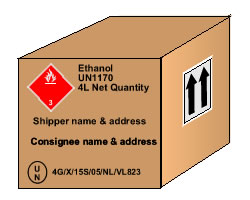MODULE 6 || Dangerous Good Packaging
As previously stated, shippers are responsible for all aspects of packing dangerous goods in compliance with the IATA Dangerous Goods Regulations. If shippers adhere to the very stringent and descriptive packaging instructions documented within the IATA DGR, then many types of dangerous goods can be safely transported by air.
Most importantly, dangerous goods packaging is manufactured and tested to a very high standard to withstand the conditions normal air transport.
Normal Conditions of Air Transport
Even under normal conditions, cargo travelling by air is subjected to extreme fluctuations in temperature, pressure and vibration.
For this reason packaging used to transport dangerous goods must be manufactured and tested to a very high standard. At a minimum, all dangerous good packaging must be able to withstand the following conditions:
Types of Packaging
There are three main types of dangerous goods packaging.
1. UN Specified Packaging
|
These packages have been manufactured and tested to a very high standard. The packages show markings in accordance with UN specifications. These packages must meet specific requirements in quality, construction and ullage (see terminology). Furthermore, these packages are designed and manufactured to resist temperature, pressure and vibrations that can occur in flight. Because of the higher manufacturing and testing standards required for UN packaging, greater quantities of dangerous goods can be shipped per package, in comparison to “Limited Quantity Packaging”. |
 |
2. Limited Quantity Packaging
|
“Limited Quantity Packaging” does not undergo the same quality control as UN packages. It has been recognised however, that some dangerous goods in smaller quantities can be transported safely. The minimum standard required for a Limited Quantity packages is as follows:
The restrictions that apply to this type of packaging are:
Note: Some classes are FORBIDDEN to be transported in Limited Quantity packages. |
 |
3. Excepted Quantity Packaging
Sending Dangerous Goods in excepted quantity packaging is very common within the scientific community. It is quite often necessary for them to send scientific and clinical specimens in small amounts of Dangerous Good preservatives.
Very small quantities (30 ml or less, 30 g or less) or less of certain dangerous goods may be transported by air and are exempted from the normal marking, labelling and documentation requirements. These are often small commercial samples such as perfumes and scientific samples in ethanol. Table 2.6.A outlines the maximum quantity allowable per inner and outer packaging that may be sent as Excepted Quantities. If an article or substance listed in Table 4.2 List of Dangerous Goods ("Blue Pages") does not have an EQ Code, it cannot be sent as Excepted Quantities.
Dangerous Goods transported in excepted quantities will have the following mark affixed to one face of the package for identification purposes:
 |
|
Note 1: Dangerous goods in excepted quantities are not permitted as checked or carry-on-baggage nor in the mail.
Note 2: Some Classes of dangerous goods are FORBIDDEN to be transported in Excepted Quantities.
Note 3: The IATA DGR reference 2.6 must be referred to when sending dangerous good in accepted quantities.


